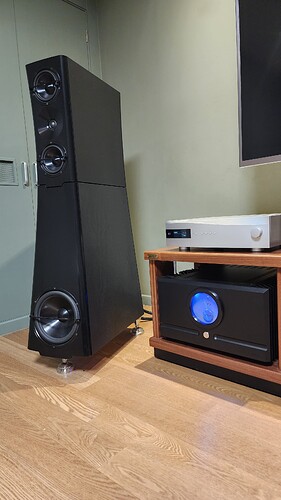After trying a pair of 10+yrs old Pass X600s(silver), I was so satisfied that I bought a new pair of X600.8s(black).
They are hooked to dCS Rossini apex and YG Sonja 2.2i in my rather small study.
The sound is colossal and is truely like watching Tsunami rushing into me.
Comparimg to old X600s, the new X600.8s sound a little more edge probably because they need some ageing time.
I will see how they change…
Congrats, big difference between both version. Always no preamp ?
Lovely! You don’t see the Pass gear in black very often. Yum.
Beautiful!
You need a bigger room for this impressive combination.
Put the kids in the basement! ; )
About adding a preamp, when using XLR connection;
- the output impedance of dCS is 3 ohms regardless of the output volume level (the volume level between -30db to 0db using output volatage is recommended to improve SN ratio from imbedded analogue noise level from dCS.
- the output impedance of Pass XP22 is 25 ohms.
- the input impedance of Pass X600.8 is 100k ohms.
Therefore, I do not see any benefit of adding a preamp for impedance matching unless I want to have some coloration of the sound.
Even if a few preamps have less than 3 ohms output impedance, 3 ohm is low enough for me.
I will be very glad to hear benefits of adding a preamps other than coloration.
The rather small study room is the main listening room and the sonjas were the the bigger living room. I was afraid if the Sonjas were too big in the study, but after trying with X600.8 the bass cotrol was excellent in the space and the colossal sound gives me to another sonic experience, which I still need getting used to.
Rossi apex simply plays beautiful!
I do enjoy the little Pass XP-12 very much. My power amp would require an adapter from XLR to RCA to try without the preamp, which I am still planning to try soon. The balanced output stage of all dCS dacs - don’t know about Varese though - just sounds a lot better than the single-ended. I have noticed that going out balanced on quite a basic xlr-cable beats an expensive rca cable on my Vivaldi. Then there’s more expensive cables ![]()
You have a lot of preamp that doesn’t add any coloration. Preamp is like a conductor.
Yes, the single ended and balanced output stages are separate designs rather than the single ended design being derived from one leg of the balanced output as is the case in some competitive products. This has always been the case but is emphasised in Apex units where the single ended output stage remains as the original design but the balanced output stage has been improved. Presumably as the output stage of Apex is derived from Varese they are similar in this respect but if anyone has better information please advise. Thus balanced will always sound preferable everything else being equal.
The use of adaptors from RCA to XLR is not recommended ( I once experimented for some reason now forgotten ![]() ). Custom cables may prove preferable but in either case you will lose a major advantage of differential balanced connection as it will remain single ended and lose CMR ( the reduction of unwanted noise).
). Custom cables may prove preferable but in either case you will lose a major advantage of differential balanced connection as it will remain single ended and lose CMR ( the reduction of unwanted noise).
If a preamp does not add coloration, what is the point of adding one for digital souce only users like me?
Coloration is by and large a negative connotation. Any component or cable can have a certain character which it imparts. It is up to you if you like a certain character, e.g. having a certain distortion profile (even or odd harmonics) creating aspects such as soundstage width and depth.
Any component will have such characteristic, in the end it matters what you like and if you get a more emotional connection to the music by adding in this case a preamp or not.
In a way, the mapper, upsampler and filter settings in a dCS digital frontend also do this and there is no one right setting.
Possibly but this should not be confused with the fact that genuine width and depth are captured in the recording or at least those made so that the environment in which the performers are is captured. These days it is mainly classical recordings that do this.
According to Nelson Pass: “from listening tests we learn that there is a tendency to
interpret negative phase 2nd as giving a deeper soundstage and improved localization than
otherwise. Positive phase seems to put the instruments and vocals closer and a little more
in-your-face with enhanced detail”, see: art_h2.pdf page 5, but the rest of the article is also very informative even if you are not into building the diy circuit.
Thanks for the good info. ![]()
Yes those effects may be so but , as I aid:
Every amplifier has distortion and a distortion profile. Nelson Pass is just very honest about it. His amplifiers always measure better than the specifications suggest. It’s not because Pass talks about distortion that other amplifiers have none. Also, the article is for a second harmonic distortion device to experiment.
